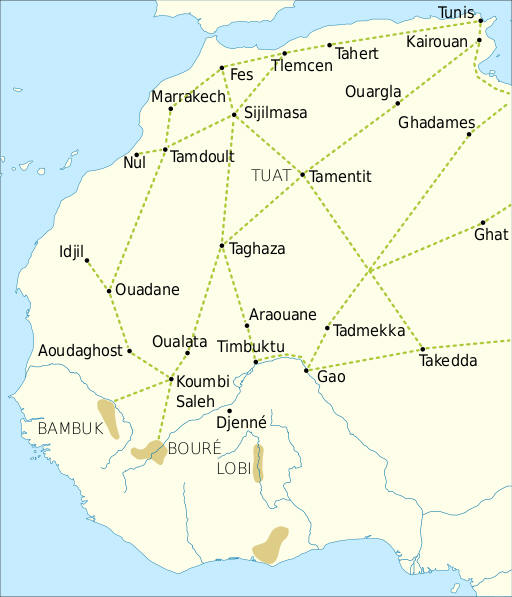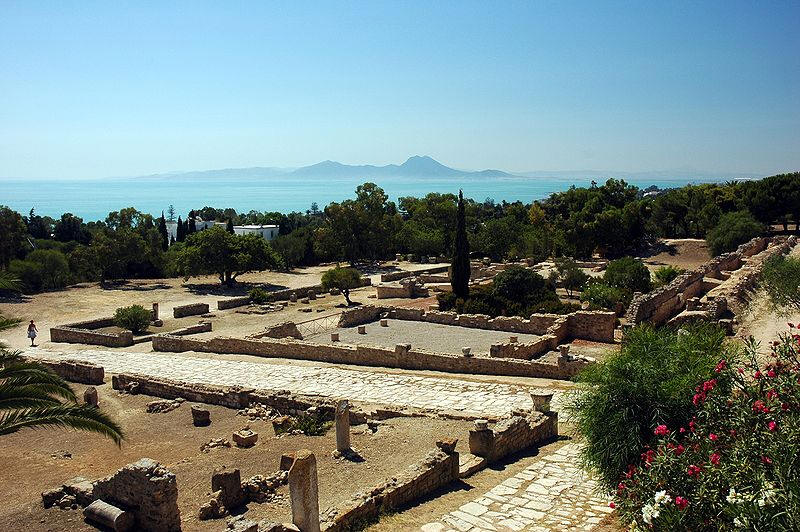
Chapter 8 Early African Civilizations: 1800 B.C.-1235 A.D.
Section
3
North
Africa was part of a wider world, the Mediterranean basin, which included Asia
and Europe. In this world, ideas
spread and people interacted a great deal.
The region added to the progress of the early years made in Egypt and
elsewhere, notably in the areas of agriculture, urbanization and trade. The use
of iron became widespread, agriculture improved, and two animals, the horse and
the camel, contributed to the building of better armies and trade. Advances in
civilizations and interactions within a wider world are the two themes that
dominated the history of this region.
Metal,
Agriculture and Trade
As
civilization had developed early on in the Nile Valley, by 1800 B.C. many parts
of North Africa knew about agriculture, urbanization, and centralized political
authorities. After this date,
enormous improvements were made in civilized life as cities and trade expanded,
and great changes occurred in the political systems.
The
Iron Age in the north. One
of the most decisive changes was the spread of iron technology. Beginning about
650 B.C. North Africa entered the Iron Age. As elsewhere, iron accelerated the
development of both agriculture and pastoralism. Replacing copper, iron was more
plentiful and could be used to forge harder, cheaper and more durable weapons
and tools to produce more food, build better houses, and master the environment.
Iron became a source of military power, allowing stronger people to control
weaker ones. States and organized governments emerged, partly to meet the
challenges of growing population and urbanization.
Farming and pastoralism became established ways of life for the majority
of the population. Among the Berbers and others in the Maghrib,
the area from the Atlantic to the western borders of Egypt, pastoralists sold
milk and meat to sedentary farmers in exchange for grain and oil. Sedentary
farmers contributed to greater food production and urban cultures. Pastoralists
took care of the countryside: wandering and hunting enabled them to develop
better mobility and fighting techniques. Whether
as sedentarists or pastoralists, community life among the Berbers was organized
around an ethnic group and loyalty to a strong leader who must protect his
people, their land and means of livelihood.[22]
Horses
and camels. As in
southwest Asia, the introduction of the horse sometime after about 1700 B.C.,
along with the new war chariot first pioneered by the Indo-European peoples,
caused significant changes in northern Africa. Before then, people relied on
donkeys for transportation, and fought wars on foot.
By 1235 B.C., however, chariots had become popular: the Berbers used them
in their wars and to cross the Sahara desert.[23]
After about 900 B.C. war chariots gave way to cavalry, with enormous
social and political consequences: cavalry increased mobility; techniques of
horse training improved; new breeds of horses were raised to transport people
over long distances; and the art of warfare reached a new level.
Perhaps even more important than the use of the horse was the
introduction of the domesticated camel from Arabia. The camel was able to
withstand heavier loads than a donkey. In addition, it could go long periods
without water, and withstood the heat of the desert better than either horses or
donkeys. After about 1000 B.C., the camel improved communications between the
Nile Valley and its Arabian neighbors as it was used on the routes between the
Nile and the Red Sea. By the 1st
century A.D. camel culture had spread to North Africa, with consequent
improvements in travel and trade.
The
trans-Saharan trade. The
trans-Saharan trade between North and West Africa was also improved by the use
of the camel. The Berbers in the
Atlas Mountains and the northern Sahara served as intermediaries to carry goods
across the desert. The trade brought the goods of West Africa—gold, ivory, and
slaves—to the north in exchange for salt, cloth, beads and metal. This was an
international trade that connected Africa with the Middle East and Europe. The Saharan Berbers sold West African goods to traders from the north who
in turn sold them to Asians and Europeans. West African gold and ivory were
highly sought in North Africa. West Africa was the leading supplier of gold to
Europe until the 1500s.
The trans-Saharan trade contributed enormously to building the glory and
splendor of such towns as Carthage, Sabratha, and Leptis well before 400 AD.
Trading cities also grew among the Berbers: those such as Audoghast and
Sijilmasa have disappeared; some like Oualata and Tichitt still exist although
they are no longer important; and others like Agades, Ghat, and Murzuk are alive
and doing well.
While the trade was profitable, crossing the Sahara was difficult, risky,
and long. One person who crossed it
and left a first hand account was an Arab traveler named Ibn Batuta. From Fez,
the leading trade center of northern Morocco, he traveled south, first to the
trading city of Sijilmasa, where he had to purchase enough food to last four
months for his camels, and then on to Tagazha, a salt-producing town in the
desert. On reaching Taghaza, obtaining water was difficult,
and after leaving this town, one would not come across an oasis for ten days.
Many people died without completing the journey.

North
Africa and the Sahara
North
Africa was in many ways the crossroads of the continent. As peoples from beyond
Africa’s shores settled or traded there they interacted with local peoples and
contributed to the spread of technology, ideas, and even population. The
Phoenicians, Greeks and Romans all took control of the local Berber peoples of
North Africa at one time or another. With them they brought the stimulus needed
to foster both trade and the development of cities.
The
Carthaginian Period.
From about 1000 B.C. seafaring Phoenicians in search of gold, copper, silver,
lead and other metals had established trading stations along the North African
coast.[24]
By 800 B.C., these trading stations had grown into colonies. With the
fall of Phoenicia to the Assyrians these colonies became largely independent.
Carthage, in present-day Tunisia, the most famous of these colonies, was
established among the Berbers of North Africa. Along the coastal strip, Carthage
grew into an empire in its own right.

Ruins of Carthage, from http://upload.wikimedia.org/wikipedia/commons/thumb/a/a7/Tunisie_Carthage_Ruines_08.JPG/800px-Tunisie_Carthage_Ruines_08.JPG
Under the Carthaginians, the use of iron spread rapidly. Phoenicians inter-married with the Berbers, agriculture developed further as the countryside supplied the cities with food, and trade expanded to the Atlantic coast of North Africa. By 600 B.C. Carthage had become a leading city and the wealthiest in the Western Mediterranean. This power was built on the trans-Saharan trade: with cheap manufactured goods, Carthage obtained metals. In search of further wealth, the Carthaginians even established their own colonies in Spain and Sicily, and on other islands in the western Mediterranean.
In Sicily, however, the Carthaginians clashed with the local Greek
city-states. After a major defeat by the Greeks of Sicily in the late 400s,
Carthage was for a time isolated. During this period the kingship gave way to a
ruling oligarchy. Although, like Rome, Carthage had an assembly of the people
and a Senate, the real rulers were the wealthiest merchant families. These
families controlled elections and generally determined who would be the
magistrates and generals of the republic.
Carthage became a great urban culture. Like other cities in the
Mediterranean, it too became largely Hellenized during the Hellenistic period.
Unlike the Greeks, however, the Carthaginians did not give up their original
Phoenician religion—the worship of the god Molok, complete with periodic
sacrifices of the sons of leading families to appease the god in times of
trouble or danger. (In later years these sacrifices were usually slave children
adopted by the leading families to take the place of their own.)
As Carthage rose to power in North Africa, surrounding Berbers also began
to develop states of their own in self-defense—notably the kingdoms of Numidia
and Mauretania. Meanwhile, Carthaginian interest revived in both Sicily and
Spain. The imperial interest of Carthage in Spain and Sicily brought it into
struggles with the Romans. Despite the efforts of the Barca family, particularly
its most famous member, Hannibal, eventually Carthage was destroyed by Rome in
the late 200s B.C.. Thereafter the Maghrib fell under Roman domination.
The
Graeco-Roman Period. By
the first century A.D., Greek and Phoenician rule in North Africa had given way
fully to that of Rome. North Africa became a source of raw materials, as the
Romans exploited the area for olive oil and grain, which was carried to the
imperial city of Rome. Indeed, Egypt and the Maghreb became the granary of Rome.
Taxation was high, and so intense was the exploitation of the peasantry that
many took to banditry and rebellion.
Roman North Africa was divided along class lines.
A ruling class and wealthy merchants lived in the coastal cities. They
had large estates, cultivated by slaves of Berber origin. Outside the cities and
large estates were the tax-paying Berbers who kept their language and culture
and often resented Roman rule. The Roman wars of conquest, and on-going
resistance to Roman rule, helped the Berbers to improve their own military
skills. In some places like Numidia, although Roman armies conquered local
kings, the defeated were allowed for a time to remain semi-independent as Roman
allies.
Roman civilization became even more urban and sophisticated than that of Carthage. Not less than 500 cities developed in North Africa, with close to 2 million people living in them. Many great buildings were constructed for religious, living and entertainment purposes. A road network connected them with each other and with the major ports along the coast.
The
Spread of Christianity. Under
Roman rule, Christianity spread to many parts of North Africa. Alexandria, the
commercial capital of Egypt, was one of the most important centers of
Christendom during the first century. Many
early Christian scholars lived in Alexandria, and they left works that defined
the theology of the religion. In Egypt, a monastic tradition developed:
religious people lived in isolation to devote their entire time to spiritual
upliftment.
Even after the Roman Empire had adopted Christianity, in Egypt the
‘Coptic’ church emerged that remained distinct from the Roman Church. Based
in Alexandria, the Coptic Church used a local Coptic language for worship and
denied that Jesus Christ, while divine, could also have been an ordinary human
being. Between 500 and 600 AD
Coptic Christians carried their religion southwards into Nubia, where they
converted many and left a Christian legacy still in existence.
From Egypt, Christianity also spread westwards to the Berbers where it
found a mass appeal. Priests and Bishops were appointed among the Berbers,
including the notable Aurelius Augustinus (354-430 A.D.), a Christian convert of
Numidia who was to become Saint Augustine of Hippo. Saint Augustine is today
recognized as one of the founding fathers of Roman Catholic Christian doctrine.